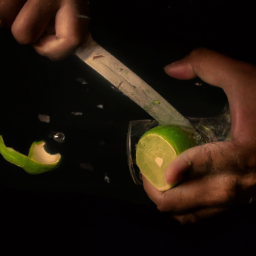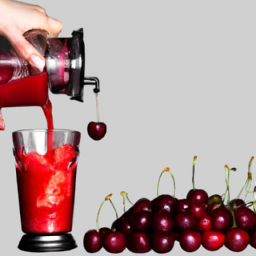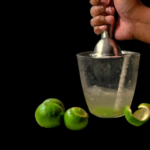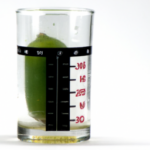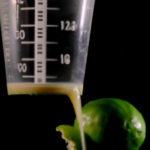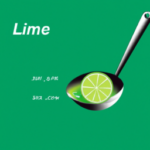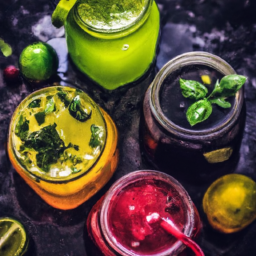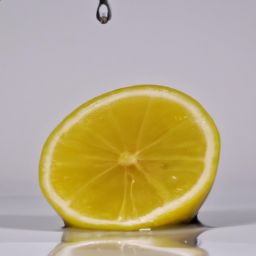I used to think that only bartenders or professional chefs used fresh lime juice. But I discovered its benefits when I started adding a splash of lime to my water daily or using it in marinades for grilled chicken. However, I didn’t have a juicer at home and was hesitant to buy one.
That’s when I learned how to juice lime without a juicer, and it’s been a game changer ever since. If you’re like me and love the taste and health benefits of fresh lime juice, but don’t want to invest in a juicer, then you’re in luck.
In this article, I’ll share with you the tools and techniques for getting the most juice out of a lime without a juicer. Whether you’re making a margarita or adding a zesty kick to your salad dressing, juicing a lime has never been easier. So, grab a lime and let’s get started!
Key Takeaways
- There are alternative methods for juicing lime without a juicer, such as using a fork, spoon, sieve, cheesecloth, citrus reamer, or hand squeezing.
- Proper knife techniques and safety precautions should be followed when juicing lime with a knife.
- Rolling, microwaving, and crosswise cutting can help maximize juice yield when juicing lime.
- Lime juice is a versatile ingredient that can be used in cocktails, marinades, sauces, dressings, and desserts, and has benefits such as tenderizing meat, aiding digestion, and boosting the immune system. Proper storage in an airtight container and use within a week can prevent spoilage.
Why Fresh Lime Juice is Important
Fresh lime juice’s zesty flavor and vital nutrients make it an essential ingredient in many recipes. Whether you’re making a refreshing cocktail or adding a burst of tang to your cooking, fresh lime juice can elevate the taste of any dish.
Using fresh lime juice has a number of benefits, including enhancing the flavor of your food and providing a boost of Vitamin C. In cocktails, fresh lime juice can add a tart and refreshing taste that balances out the sweetness of other ingredients. It can also be used to cut through the richness of creamy cocktails, making them more refreshing and easy to drink.
In cooking, fresh lime juice can be used in marinades to tenderize meat, add flavor to sauces, and brighten up the taste of vegetables. Additionally, the high Vitamin C content in lime juice can help boost your immune system and keep you healthy. With all these benefits, it’s clear that using fresh lime juice is a must in any kitchen or bar.
Now, let’s move on to the tools you will need to juice limes without a juicer.
Tools You Will Need
To prepare fresh lime juice, you’ll need a few basic tools in your kitchen. First, you’ll need a sharp knife to cut the lime into smaller pieces.
Then, a fork can be used to help extract as much juice as possible from the lime.
Finally, a spoon can be used to scoop out any remaining pulp or seeds.
Having these tools on hand will make the juicing process much easier and more efficient.
Knife
Using a sharp knife, you can easily extract the juice from a lime without the need for a juicer. However, it’s important to use proper knife techniques and prioritize safety when handling sharp objects.
Here are some tips on how to use a knife to juice a lime:
-
Start by washing the lime and drying it thoroughly.
-
Cut off the ends of the lime to create a flat surface for stability.
-
Slice the lime in half lengthwise.
-
Hold one half of the lime with the cut side facing down and use a small serrated knife to make small cuts along the flesh, being careful not to puncture the skin.
To move on to the next step of juicing the lime, you can use a fork to help extract the juice.
Fork
If you’re like me, sometimes you just don’t feel like digging out the juicer, so a fork can be a great alternative for getting every last drop of citrusy goodness out of that lime. Using a fork to juice limes may seem unconventional, but it can be just as effective as using a juicer or a reamer. In fact, using a fork can even have some benefits over other methods.
One benefit of using a fork is that it allows you to get more juice out of the lime. By using the tines of the fork to pierce and twist the lime, you can effectively break down the pulp and release more juice. Additionally, using a fork can be a more cost-effective and environmentally-friendly option as it doesn’t require any additional gadgets or tools.
Moving on to the next method, using a spoon can also be an effective way to juice a lime.
Spoon
Now, when you’re in a pinch and need to extract every last bit of citrusy goodness, grab a spoon and get ready to scoop out that luscious lime juice. Using a spoon for juicing may seem unorthodox, but it’s actually a handy tool for those who don’t have a juicer on hand.
The benefits of using a spoon over a juicer are that you can get every last drop of juice out of the lime, and it’s also less messy than using a juicer. To use a spoon for juicing, simply cut the lime in half and hold one half with the cut side facing up.
Insert the spoon into the center of the lime and gently twist it back and forth to loosen the juice. Then, use the spoon to scoop out the pulp and juice, being careful not to get any seeds in the mixture. Once you’ve finished with one half, repeat the process with the other half.
Now that you know how to extract lime juice using a spoon, the next step is to cut the lime in half.
Cut the Lime in Half
First things first, grab that lime and slice it in half like a ninja slicing through a watermelon. This is the first step in juicing techniques that’ll allow you to extract the most juice from your lime without a juicer.
Here are four tips to make sure you get the most out of your lime:
-
Use a sharp knife: A dull knife will make it harder to slice through the lime and may result in uneven halves.
-
Cut lengthwise: Cut the lime lengthwise, from top to bottom, to get the most juice out of each half.
-
Use a cutting board: This’ll prevent any injuries and ensure a flat surface for cutting.
-
Rotate the lime: Once you’ve cut the lime, rotate it 180 degrees and cut it again. This’ll help you get the most juice out of each half.
Now that you have your lime halves, it’s time to move onto the next step: squeezing the juice out.
Squeeze the Lime Halves
You’re ready to extract every last drop of tangy goodness from those lime halves, so grab one and give it a firm squeeze with your hand. Hand juicing techniques can be just as effective as using a juicer, and you’ll be able to taste the difference in the resulting fresh lime juice.
To ensure that you get the most juice out of your lime, hold it firmly in one hand and use the other hand to apply pressure to the top of the lime half. Roll the lime back and forth a few times before squeezing to help loosen up the juices inside.
There are many benefits of fresh lime juice, including its high vitamin C content and ability to aid digestion. Plus, it adds a bright, citrusy flavor to a variety of dishes and drinks.
Once you’ve squeezed all the juice out of your lime halves, it’s time to strain the juice to remove any seeds or pulp.
Strain the Juice
Now that I’ve squeezed the lime halves, it’s time to strain the juice to remove any pulp or seeds.
There are two common ways to do this: using a sieve or using a cheesecloth. Using a sieve is the quicker and easier method, as you simply pour the juice through the sieve to catch any unwanted bits.
Using a cheesecloth takes a bit more time and effort, as you have to place the cheesecloth over a bowl, pour the juice onto the cheesecloth, and then gather the corners of the cloth to squeeze out the juice.
Using a Sieve
To get every last bit of juice out of your lime, simply press it hard against a sieve and watch as the liquid flows effortlessly through the tiny holes, like a river rushing through a narrow canyon.
Using a sieve is one of the easiest and most common ways to juice limes without a juicer. If you don’t have a sieve, you can use a fine mesh strainer or even a piece of cheesecloth to achieve the same effect.
When using this method, it’s important to apply as much pressure as possible to the lime to extract all the juice. This may require twisting the lime back and forth or even using a spoon to press down on the fruit.
The resulting juice can be used in a variety of recipes, from cocktails to marinades to salad dressings. If you’re looking for a quick and efficient way to juice limes without a juicer, using a sieve is definitely worth a try.
Now, let’s move on to the next method for juicing limes without a juicer: using a cheesecloth.
Using a Cheesecloth
If you want to achieve maximum extraction of the tangy goodness from your limes, using a cheesecloth is a great option. It’s a simple and effective way to get every last drop of juice from your lime. Here’s how to do it:
- Cut your lime in half.
- Place a cheesecloth over a bowl or pitcher.
- Hold your lime half over the cheesecloth, cut side down.
- Squeeze the lime half as hard as you can, letting the juice flow through the cheesecloth and into the bowl.
- Repeat with the other half of the lime.
Using a cheesecloth is just one of the many alternative methods for juicing limes without a juicer. If you don’t have a cheesecloth, you can also try using a fork or a citrus reamer.
Alternative Methods
Grab a sharp knife and slice the lime in half. Then, hold one half with the cut side facing down over a bowl and squeeze it tightly with your hand, allowing the juice to trickle through your fingers and into the bowl. This is one of the easiest and most effective ways to juice a lime without a juicer.
However, if you’re looking for other alternatives, here are some other methods to consider:
- Use a fork to pierce the lime all the way around and then roll it on a hard surface to help release the juice.
- Microwave the lime for about 10-15 seconds to help soften it up and make it easier to squeeze.
- Use a citrus reamer to extract the juice from the lime.
- Use a handheld citrus squeezer for a more efficient way to squeeze the lime.
These methods can be helpful if you don’t have a cheesecloth or juicer available. However, it’s important to note that each method may yield different amounts of juice, so it’s best to experiment and find which one works best for you.
Now, let’s move on to some tips for getting the most juice out of your lime.
Tips for Getting the Most Juice
Maximize your lime’s potential by pressing it firmly against the countertop and rolling it back and forth with your palm before cutting it. This technique helps to break down the lime’s fibers and release more juice.
You can also microwave the lime for a few seconds before juicing it to soften it up and make it easier to extract the juice.
To further maximize yield and reduce mess, cut the lime in half crosswise instead of lengthwise. This allows you to squeeze the lime more efficiently and get more juice out.
Additionally, using a fork to extract the juice can be more effective than using a citrus squeezer as it allows you to reach every last drop of juice.
With these tips, you’ll be able to extract the most juice from your limes and enjoy a refreshing drink or recipe.
When you’re done, learn how to store your lime juice for future use.
Storing Lime Juice
Don’t let your leftover lime juice go to waste – store it properly to ensure that you can enjoy its tangy flavor in future recipes! Storing lime juice is simple, but it’s important to do it right to prevent spoilage.
First, transfer the juice into an airtight container, such as a glass jar with a tight-fitting lid. This will prevent air from getting in and causing oxidation, which can lead to spoilage.
Next, store the container in the refrigerator. The low temperature will slow down the growth of bacteria and other microorganisms that can spoil the juice. It’s best to use the lime juice within a week, but it can stay fresh for up to two weeks if stored properly.
Now that you know how to store lime juice, you can enjoy its tangy flavor in all sorts of recipes, from marinades and dressings to cocktails and desserts.
Looking for ideas for using fresh lime juice? Try adding it to guacamole or salsa for a zesty kick, or use it to make a refreshing limeade. You can also use lime juice to marinate chicken or fish, or to make a delicious vinaigrette for salads. The possibilities are endless, so experiment and have fun with this versatile ingredient!
Ideas for Using Fresh Lime Juice
You can add a tangy twist to your favorite cocktail by squeezing fresh lime juice into the mix. Imagine sipping on a refreshing margarita with a zesty kick!
Lime juice cocktails are a staple in my household, especially during the summer months. I also love incorporating fresh lime juice into my desserts for a burst of flavor.
One of my favorite lime-infused desserts is key lime pie. The tartness of the lime balances perfectly with the sweetness of the condensed milk and graham cracker crust.
I also love using lime juice to make a simple glaze for pound cake or drizzling it over fresh fruit for a healthy and refreshing snack. The possibilities for using fresh lime juice in your cooking and baking are endless!
Frequently Asked Questions
Can I use bottled lime juice instead of fresh lime juice?
I wouldn’t recommend using bottled lime juice instead of fresh. The benefits of using fresh lime juice are numerous, including better flavor and higher vitamin C content. There is a noticeable difference in taste between bottled and fresh lime juice.
How long can I store fresh lime juice in the fridge?
I store fresh lime juice in a glass container with an airtight lid in the fridge for up to a week. To prevent spoilage, I make sure to use clean utensils and containers when handling the juice and keep it chilled at all times.
Can I use a blender to juice my limes?
Blenders are not the best alternative for lime squeezing. Lime juice can be extracted using a reamer or fork to twist and press the lime halves. This method is more efficient and produces fresher juice.
What is the best way to clean my juicing tools after use?
To keep my juicing tools clean, I always rinse them immediately after use and use a brush to scrub away any leftover pulp. For tougher stains, I soak them in a mixture of water and vinegar. Regular maintenance is key to keeping them in good shape.
Can I use lime juice from a regular lime tree or does it need to be a specific type of lime?
Yes, you can use lime juice from a regular lime tree for juicing. However, different types of limes have varying levels of acidity and flavor. Using fresh lime juice from your own tree has the added benefit of being free of preservatives and pesticides.
Conclusion
Well, there you have it – a simple and easy way to juice lime without a juicer! Fresh lime juice is essential in many dishes and drinks, and now you can always have it on hand without the need for any fancy equipment.
It may take a little extra effort, but the end result is worth it. Juicing limes can be a refreshing and satisfying experience, much like a cool breeze on a hot summer day. Don’t let the lack of a juicer stop you from enjoying the zesty goodness of fresh lime juice.
With a few simple steps, you can have the perfect addition to your favorite recipes and beverages. So go ahead, get juicing!
Ilana has been a vegan for over 10 years. She originally made the switch for health reasons, but soon found herself becoming more and more passionate about the ethical and environmental implications of a vegan lifestyle. Ilana is the author of The Graceful Kitchen, a blog all about veganism. She loves to cook up delicious and nutritious vegan meals, and share her recipes with others who are interested in leading a cruelty-free life. Ilana is also a strong advocate for using whole foods as the foundation of a healthy diet, and believes that going vegan is one of the best ways to achieve this.
